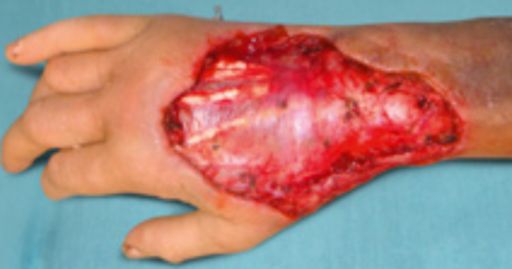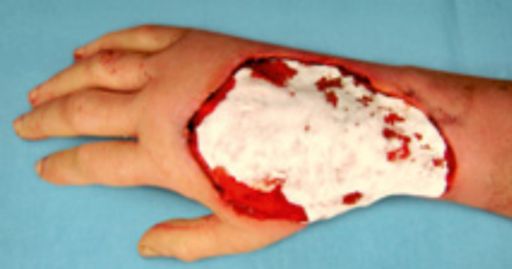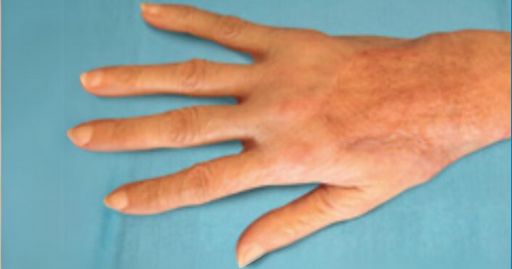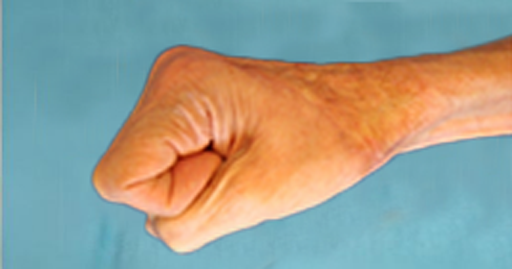Dermal matrices are pivotal in soft tissue reconstruction, establishing a robust foundation for neodermis formation and optimal re-epithelialization. However, due to the complex regenerative processes and precursors required for proper neodermis formation, traditional dermal matrices often fall short of both patient and physician expectations. As a result, soft tissue reconstruction outcomes may fail to meet adequate clinical, functional, and/or aesthetic targets in a timely manner.
Challenges with Traditional Dermal Matrices
The foundational relationship between structure and function dictates the success of a dermal matrix. When the matrix composition fails to manage the wound bed optimally, the body is unable to perform the necessary soft tissue regeneration to achieve optimal outcomes. Traditional dermal matrices are associated with:- Long vascularization timelines. Time to wound closure has a direct impact on reconstruction. Traditional dermal matrices often require 21-28 days to achieve vascularization, delaying wound closure and prolonging inflammation.1,2 This extended exposure can lead to excessive granulation tissue, increasing the risk of scar formation, wound contraction, reduced mobility, and suboptimal aesthetic outcomes.
- Increased infection rates. Delayed wound closure, resulting from inhibited angiogenesis, prolongs exposure to pathogens and elevates infection risks. Traditional dermal matrices typically have reported infection rates between 14% and 55%.3 Infections, especially in complex wounds, complicate recovery by increasing the risk of additional damage and prolonged inflammation which can significantly slow the overall healing response, resulting in even longer closure times.
- Suboptimal dermis quality. Traditional dermal matrices, derived from porcine, bovine, or fish collagen have significantly different protein structures and matrix assembly properties when compared to human dermis. These differences impact their integration and effectiveness. These dissimilarities can negatively impact functional and aesthetic outcomes.
MatriDerm: A New Era in Soft Tissue Reconstruction
Improving soft tissue reconstruction outcomes begins with a dermal matrix that provides the optimal environment for robust angiogenesis, proliferation, and closure. MatriDerm represents the latest innovation in dermal matrix technology, by combining native bovine collagen I, III, and V with added elastin to support the following beneficial outcomes:- Rapid vascularization. MatriDerm has been shown to vascularize in 3 to 7 days, allowing definitive closure with split thickness skin grafts weeks sooner than with other dermal matrices.4
- Low infection rates. Early establishment of blood supply and definitive closure has been proposed as the reason MatriDerm has reported infection rates between 0% and 5%5 vs vs 14-55% for other dermal matrices.6
- Improved neodermis quality. Use of MatriDerm and early wound closure has been shown to result in fewer myofibroblast cells7 (associated with scar contraction) and early formation of high quality neodermis.8 Therefore, MatriDerm allows excellent collagen structural organization and neodermis quality with the potential for decreased scarring, less contraction, and earlier rehabilitation and return to function.
Real Patient Outcomes
Infected Dog Bite
Courtesy of U. Hug, MD, Luzern, Switzerland
Supported by Over 20 Years of Clinical Evidence
- Dermal Substitution in Acute Burns and Reconstructive Surgery: A 12-Year Follow-Up: MatriDerm demonstrated long-term improvements in scar parameters in both acute burns and reconstructive wounds.
- Reduced wound contraction and scar formation in punch biopsy wounds. Native collagen dermal substitutes. A clinical study: Native collagen with added elastin enhanced dermal regeneration and reduced wound contraction.
- A Histological and Clinical Study of MatriDerm® Use in Burn Reconstruction: MatriDerm achieves early vascularization to support early epidermal autografting.
- Biological dermal templates with native collagen scaffolds provide guiding ridges for invading cells and may promote structured dermal wound healing: Nativity allows rapid cell attachment, motility, and proliferation.
- Management of full-thickness skin defects in the hand and wrist region: first long-term experiences with the dermal matrix Matriderm: MatriDerm achieved 96% graft take rate and excellent functional outcomes
Discover the transformative potential of MatriDerm for your clinical practice. Schedule a demo today to see firsthand how MatriDerm can enhance patient outcomes in soft tissue reconstruction.
Sources
- Schmidt VJ, Wietbrock JO, Leibig N, Gloe T, Henn D, Hernekamp JF, Harhaus L, Kneser U.; Ann Plast Surg. 2017 Jul;79(1):92-100.
- NovoSorb® BTM | Synthetic Polymer for Traumatic Wound Treatment (polynovo.com), Wagstaff MJ, Schmitt BJ, Coghlan P, Finkemeyer JP, Caplash Y, Greenwood JE. Eplasty. 2015 Apr 24;15:e13. PMID: 25987938; PMCID: PMC4412164.
- 1453796564.pdf (https://www.integralife.com)
- Lamme EN, van Leeuwen RT, Jonker A, van Marle J, Middelkoop E.; J Invest Dermatol. 1998 Dec;111(6):989-95.
- Min JH, Yun IS, Lew DH, Roh TS, Lee WJ. The use of matriderm and autologous skin graft in the treatment of full thickness skin defects. Arch Plast Surg. 2014;41(4):330-336.
- Integra 2014, Integra website, accessed 13 December 2023
- Dill V, Mörgelin M. Biological dermal templates with native collagen scaffolds provide guiding ridges for invading cells and may promote structured dermal wound healing. Int Wound J. 2020 Jun;17(3):618-630. doi: 10.1111/iwj.13314. Epub 2020 Feb 11. PMID: 32045112; PMCID: PMC7949003.
- Dickson K, Lee KC, Abdulsalam A, Amirize E, Kankam HKN, Ter Horst B, Gardiner F, Bamford A, Hejmadi RK, Moiemen N. A Histological and Clinical Study of MatriDerm® Use in Burn Reconstruction. J Burn Care Res. 2023 Sep 7;44(5):1100-1109. doi: 10.1093/jbcr/irad024. PMID: 36945134; PMCID: PMC10483478.



